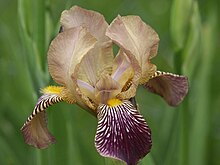Iris germanica
| Iris germanica |
 |
 |
| Scientific classification |
| Kingdom: |
Plantae |
| (unranked): |
Angiosperms |
| (unranked): |
Monocots |
| Order: |
Asparagales |
| Family: |
Iridaceae |
| Subfamily: |
Iridoideae |
| Tribe: |
Irideae |
| Genus: |
Iris |
| Subgenus: |
Iris |
| Section: |
Iris |
| Species: |
I. germanica |
| Binomial name |
Iris germanica
L.
|
| Synonyms |
List
-
- 'Iris × alba' (Savi)
- 'Iris × amoena' * 'Iris × atroviolacea' (Lange)
- 'Iris × australis' (Tod.)
- 'Iris × belouinii' (Bois & Cornuault)
- 'Iris × biliottii' (Foster)
- 'Iris × buiana' (Prodán)
- 'Iris × buiana var. virescens' (Prodán )
- 'Iris × croatica' (Prodán)
- 'Iris × croatica' (Horvat & M.D.Horvat) [Illegitimate]
- 'Iris × cypriana' (Foster & Baker)
- 'Iris × deflexa' (Knowles & Westc.)
- 'Iris × florentina' L.
- 'Iris × florentina var. pallida' (Nyman)
- 'Iris × florentinoides' (Prodán ex Nyar.)
- 'Iris × germanica var. alba' (Dykes)
- 'Iris × germanica var. amas' (Dykes)
- 'Iris × germanica var. askabadensis' (Dykes)
- 'Iris × germanica var. australis' (Tod.) (Dykes)
- 'Iris × germanica var. florentina' (L.) (Dykes )
- 'Iris × germanica var. fontarabie' (Dykes)
- 'Iris × germanica var. gypsea' (Rodigas )
- 'Iris × germanica var. kharput' Dykes
- 'Iris × germanica var. lurida' (Aiton) Nyman
- 'Iris × germanica var. nepalensis' (Wall. ex Lindl.) Herb.
- 'Iris × germanica var. sivas' (G.Nicholson)
- 'Iris × humei' (G.Don)
- 'Iris × laciniata' (Berg)
- 'Iris × latifolia' Gilib. [Invalid]
- 'Iris × lurida' (Aiton)
- 'Iris × macrantha' (Simonet)
- 'Iris × mesopotamica' (Dykes)
- 'Iris × murorum' (Gaterau)
- 'Iris × neglecta' (Hornem.)
- 'Iris × nepalensis' (Wall. ex Lindl.)
- 'Iris × nostras' Garsault (Invalid)
- 'Iris × nyaradyana' (Prodán)
- 'Iris × officinalis' (Salisb.)
- 'Iris × pallida' (Ten.) [Illegitimate]
- 'Iris pallida subsp. australis' (Tod.) K.Richt.
- 'Iris × piatrae' (Prodán)
- 'Iris × redouteana' (Spach)
- 'Iris × repanda' (Berg)
- 'Iris × rothschildii' (Degen)
- 'Iris × sambucina' L.
- 'Iris × spectabilis' (Salisb.)
- 'Iris × squalens' L.
- 'Iris × squalens var. biflora' (Prodán & Buia)
- 'Iris × squalens var. rosea' (Prodán & Buia)
- 'Iris × superba' (Berg)
- 'Iris × tardiflora' (Berg)
- 'Iris × trojana' (A.Kern. ex Stapf)
- 'Iris × varbossania' (K.Malý)
- 'Iris variegata var. lurida' ((Aiton) Nyman)
- 'Iris × venusta' (J.Booth ex Berg)
- 'Iris × violacea' (Savi)
- 'Iris × vulgaris' (Pohl)
|
Iris x germanica is the accepted name for a species of flowering plants in the family Iridaceae commonly known as the Bearded iris or the German iris. It is one of a group of hybrid origin.
Iris x germanica grows up to 120 cm high and 30 cm wide. It is a European hybrid, rather than a true wild species. The roots can go up to 10 cm deep and it is a rhizomatous perennial that blooms mid to late spring. It is known to produce the isoflavone irilone. Hundreds of hybrids exist representing nearly every colour from jet black to sparkling whites, except bright scarlet. Varieties include I. g. var. florentina and I. g. var. germanica.
Lifting, dividing and replanting the rhizomes is best done once flowering has finished as this is when the plant grows the new shoots that will flower the following year. The rhizomes are placed on the surface of the soil facing towards the sun and with at least 45cm of open ground in front of them - this allows two years growth and flowering. The plant is held in place by removing half the leaf mass to reduce wind rock and by using the old roots as anchors in the soil. The rhizome is placed on well dug ground and the roots placed either side into 10cm deep grooves. The soil is then gently firmed around the roots, so holding the plant steady. New roots and leaves are created rapidly as the rhizome moves forwards.
Clonal colony of Iris x germanica
German Iris in the UBC Botanical Garden.
...
Wikipedia


